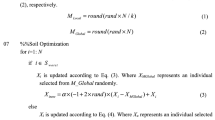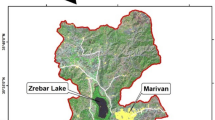Abstract
While many studies of spatial sampling have focused on optimizing only one objective, in many real-life problems, more than one objective is required to be simultaneously optimized. Hence, using multi-objective optimization techniques in spatial sampling is considerably increasing. In this paper, two bi-objective optimization problems of soil sampling are investigated. The variance of the sample mean and the mean total error are the first objective function of the first and second spatial optimization problems, respectively. Furthermore, in both Problems, the total distance travelled between sample points is considered as the second objective function. To deal with these spatial optimization problems, a new hybrid algorithm of the archived multi-objective simulated annealing algorithm and the non-dominated sorting genetic algorithm-II is developed and compared with well-known four multi-objective optimization algorithms, including the non-dominated sorting genetic algorithm-II, the multi-objective particle swarm optimization algorithm, the multi-objective grey wolf optimizer algorithm, and the archived multi-objective simulated annealing algorithm. Indeed, the performance of the algorithms is assessed and compared using four performance metrics, i.e. spacing metric, mean ideal distance, diversification metric, and spread of non-dominance solution. The parameters of the algorithms are set by the Taguchi method. Moreover, the performance of the algorithms is ranked using a hybrid multi-attribute decision-making process called the AHP-TOPSIS method. The results show that the proposed hybrid algorithm provides a Pareto frontier that dominates the frontiers resulting from other algorithms and has satisfactory diversity.
















Similar content being viewed by others
References
Abramowitz M, Stegun IA (1972) Handbook of mathematical functions: with formulas, graphs, and mathematical tables. Dover Publications, New York
Bandyopadhyay S, Saha S (2013) Unsupervised classification similarity measures. Classical and Metaheuristic Approaches and Applications. Springer, Berlin
Bandyopadhyay S, Saha S, Maulik U, Deb K (2008) A simulated annealing-based multiobjective optimization algorithm: AMOSA. IEEE Trans Evolut Comput 12(3):269–283
Barnett DT, Duffy PA, Schimel DS, Krauss RE, Irvine KM, Davis FW, Gross JE, Azuaje EI, Thorpe AS, Gudex-Cross D, Patterson M, McKay JM, McCorkel JT, Meier CL (2019) The terrestrial organism and biogeochemistry spatial sampling design for the National Ecological Observatory Network. Ecosphere 10(2):e02540
Brus DJ, Heuvelink GBM (2007) Optimization of sample patterns for universal kriging of environmental variables. Geoderma 138(1):86–95
Cao K, Batty M, Huang B, Liu Y, Yu L, Chen J (2011) Spatial multi-objective land use optimization: extensions to the non-dominated sorting genetic algorithm-II. Int J Geograph Inform Sci 25(12):1949–1969
Coello CAC, Pulido GT, Lechuga MS (2004) Handling multiple objectives with particle swarm optimization. IEEE Trans Evolut Comput 8(3):256–279
Deb K, Pratap A, Agarwal S, Meyarivan T (2002) A fast and elitist multiobjective genetic algorithm: NSGA-II. IEEE Trans Evolut Comput 6(2):182–197
Dong X, Zeng S, Chen J (2012) A spatial multi-objective optimization model for sustainable urban wastewater system layout planning. Water Sci Technol 66(2):267–274
Ehrgott M (2005) Multicriteria optimization. Springer, Berlin
Fei Z, Li B, Yang S, Xing C, Chen H, Hanzo L (2017) A survey of multi-objective optimization in wireless sensor networks: metrics, algorithms, and open problems. IEEE Commun Surv Tutor 19(1):550–586
Figueira J, Greco S, Ehrgott M (2005) Multiple criteria decision analysis: state of the art surveys. Springer, New York
Guedes LPC, Ribeiro-Jr PJ, De Stefano PS, Uribe-Opazo MA (2011) Optimization of spatial sample configurations using hybrid genetic algorithm and simulated annealing. Chilean J Stat 2(2):39–50
Hahsler M, Hornik K (2007) TSP-Infrastructure for the traveling salesperson problem. J Stat Softw Articles 23(2):1–21
Hwang CL, Yoon K (1981) Multiple attributes decision making methods and applications. Springer, Berlin
Kirkpatrick S, Gelatt CD, Vecchi MP (1983) Optimization by simulated annealing. Science 220(4598):671–680
Kitanidis PK (1987) Parametric estimation of covariances of regionalized variables. JAWRA J Am Water Resour Assoc 23(4):557–567
Lark RM (2002) Optimized spatial sampling of soil for estimation of the variogram by maximum likelihood. Geoderma 105(1):49–80
Lark RM (2016) Multi-objective optimization of spatial sampling. Spatial Stat 18:412–430
Li X, Gao B, Bai Z, Pan Y, Gao Y (2020) An improved parallelized multi-objective optimization method for complex geographical spatial sampling: AMOSA-II. ISPRS Int J Geo Inform 9(4):236
Lotfian E, Mohammadzadeh M (2021) A multi-objective sampling design for spatial prediction problem. In: Proceedings of the 3rd BYMAT Conference, Valencia, 1-3 December 2020, 2, 163-166
Maghsoudlou H, Afshar-Nadjafi B, Niaki STA (2016) A multi-objective invasive weeds optimization algorithm for solving multi-skill multi-mode resource constrained project scheduling problem. Comput Chem Eng 88:157–169
Marchant BP, Lark RM (2007) Optimized sample schemes for geostatistical surveys. Math Geol 39(1):113–134
Matérn B (1986) Spatial variation. Springer, Berlin
McBratney AB, Webster R, Burgess TM (1981) The design of optimal sampling schemes for local estimation and mapping of regionalized variables-I: theory and method. Comput Geosci 7(4):331–334
Minasny B, McBratney AB (2005) The Matérn function as a general model for soil variograms. Geoderma 128(3–4):192–207
Mirjalili S, Mirjalili SM, Lewis A (2014) Grey wolf optimizer. Adv Eng Softw 69:46–61
Mirjalili S, Saremi S, Mirjalili SM, Coelho LDS (2016) Multi-objective grey wolf optimizer: a novel algorithm for multi-criterion optimization. Expert Syst Appl 47:106–119
Molla A, Zuo S, Zhang W, Qiu Y, Ren Y, Han J (2022) Optimal spatial sampling design for monitoring potentially toxic elements pollution on urban green space soil: a spatial simulated annealing and k-means integrated approach. Sci Total Environ 802:149728
Qin CZ, Gao HR, Zhu LJ, Zhu AX, Liu JZ, Wu H (2018) Spatial optimization of watershed best management practices based on slope position units. J Soil Water Conserv 73(5):504–517
Rahmati SHA, Hajipour V, Niaki STA (2013) A soft-computing Pareto-based meta-heuristic algorithm for a multi-objective multi-server facility location problem. Appl Soft Comput 13(4):1728–1740
Réquia-Júnior WJ, Roig HL, Koutrakis P (2015) A spatial multicriteria model for determining air pollution at sample locations. J Air Waste Manag Assoc 65(2):232–243
Saadatpour M (2020) An adaptive surrogate assisted CE-QUAL-W2 model embedded in hybrid NSGA-II_AMOSA algorithm for reservoir water quality and quantity management. Water Resou Manag 34(4):1437–1451
Saaty TL (2008) Decision making with the analytic hierarchy process. Int J Serv Sci 1(1):83–98
Secrest BR, Vasquez JR (2009) Optimal spatial sampling of hyperspectral imagery for fusion with panchromatic video in multitarget tracking. In: 2009 IEEE Sensors Applications Symposium, 255-260
Stein ML (2006) Interpolation of spatial data: some theory for kriging. Springer, Dordrecht
Susanto F, Budi S, de Souza P, Engelke U, He J (2016) Design of environmental sensor networks using evolutionary algorithms. IEEE Geosci Remote Sens Lett 13(4):575–579
Tadayon V, Torabi M (2022) Sampling strategies for proportion and rate estimation in a spatially correlated population. Spatial Stati 47:100564
Taguchi G (1986) Introduction to quality engineering: designing quality into products and processes, 658.562 T3
Van Groenigen JW, Stein A (1998) Constrained optimization of spatial sampling using continuous simulated annealing. J Environ Qual 27(5):1078–1086
Van Groenigen JW, Pieters G, Stein A (2000) Optimizing spatial sampling for multivariate contamination in urban areas. Environmetrics 11(2):227–244
Wadoux AMC, Marchant BP, Lark RM (2019) Efficient sampling for geostatistical surveys. Eur J Soil Sci 70(5):975–989
Wang J, Ge Y, Heuvelink GBM, Zhou C (2014) Spatial sampling design for estimating regional GPP with spatial heterogeneities. IEEE Geosci Remote Sens Lett 11(2):539–543
Webster R, Oliver MA (1990) Statistical methods in soil and land resource survey. Oxford University Press, Oxford
Webster R, Oliver MA (2007) Geostatistics for environmental scientists. Wiley, Chichester
Yan S, Xu X, Xu D, Lin S, Li X (2012) Beyond spatial pyramids: a new feature extraction framework with dense spatial sampling for image classification. In: European Conference on Computer Vision, 473-487
Zhou B, Yang YF (2021) A coupling model and ADMM algorithm based on TGV and shearlet regularization term for MRI reconstruction. Comput Appl Math 40(3):1–19
Zhu Z, Stein ML (2006) Spatial sampling design for prediction with estimated parameters. J Agric Biol Environ Stat 11(1):24–44
Zimmerman DL, Holland DM (2005) Complementary co-kriging: spatial prediction using data combined from several environmental monitoring networks. Environmetrics 16(3):219–234
Zitzler E (1999) Evolutionary algorithms for multiobjective optimization: methods and applications, Ph.D. Thesis, Swiss Federal Institute of Technology Zurich
Zitzler E, Thiele L (1998) Multiobjective optimization using evolutionary algorithms-A comparative case study. In: International Conference on Parallel Problem Solving From Nature 292-301
Acknowledgements
Receiving support from the Center of Excellence in Analysis of Spatio-Temporal Correlated Data at Tarbiat Modares University is acknowledged.
Author information
Authors and Affiliations
Corresponding author
Additional information
Communicated by Ernesto G. Birgin.
Publisher's Note
Springer Nature remains neutral with regard to jurisdictional claims in published maps and institutional affiliations.
Rights and permissions
Springer Nature or its licensor (e.g. a society or other partner) holds exclusive rights to this article under a publishing agreement with the author(s) or other rightsholder(s); author self-archiving of the accepted manuscript version of this article is solely governed by the terms of such publishing agreement and applicable law.
About this article
Cite this article
Lotfian, E., Mohammadzadeh, M. Multi-objective optimization of spatial sampling using a new hybrid AMOSA_NSGA-II algorithm. Comp. Appl. Math. 42, 24 (2023). https://doi.org/10.1007/s40314-022-02161-1
Received:
Revised:
Accepted:
Published:
DOI: https://doi.org/10.1007/s40314-022-02161-1




